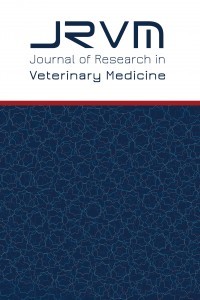Bir Köpekte Aşırı Doz Neostigmin Uygulanması Sonucu Şekillenen Tetraparezi Olgusu ve Sağaltım Sonuçları
Sekiz aylık, Rotweiller ırkı, erkek bir köpek, ani şekillenen felç nedeniyle kliniklerimize sevk edildi. Kö-peğin son günlerde konstipasyon şikayeti çekmesi nedeniyle barsak peristaltiğini arttırmak için B1-B6 vitamini, neostigmin ve parafin likit uygulandığını belirtildi. Bu uygulama sonrası ekstremitelerinde güçsüzlük, inkoordi-nasyon, tetraparezi, solunum güçlüğü, kusma ve yumuşak kıvamlı defekasyon görüldüğü ve tedavi olarak dek-sametazon ve sıvı sağaltımı uygulandığı bildirildi. Klinik ve nörolojik muayeneler sonucu hastada tetraparezi tanımlandı ve atropin sülfat uygulamasına cevap alınamadı. B1 – B6 vitamini, E vitamini - selenyum ve sıvı uygulaması ile birlikte diklofenak sodyum, ranitidin ve ampisilin-sulbaktam tedavi protokolü olarak seçildi. Diklofenak sodyum uygulamasının 2. gününden itibaren kademeli olarak hastada düzelme ve 10 günde tamamen klinik geri dönüş gözlendi.
p.p1 {margin: 0.0px 0.0px 0.0px 0.0px; font: 12.0px 'Times New Roman'; min-height: 15.0px}
p.p2 {margin: 0.0px 0.0px 0.0px 0.0px; font: 10.0px 'Times New Roman'}
span.s1 {font: 12.0px 'Times New Roman'}
span.s2 {font: 6.5px 'Times New Roman'}
Anahtar Kelimeler:
Neostigmin, tetraparezi, diklofenak sodyum, köpek
The case of Tetraparesia Resulted from Hyperdose Neostigmine Application and Its Treatment Results
Eight-month-old, Rottweiler breed, a male dog was referred to our clinics with the cause of sudden onset paralysis. Due to recently encountered constipation problem, it was informed that B1-B6 vitamin, neostig-mine and paraffin liquid had been applied to increase the intestinal motility. Following the application, it was emphasized that limb weakness, in coordination, tetraparesis, dispnea, vomiting and soft defecation had seen, and dexamethasone and fluid therapy had been applied. After clinic and neurologic examinations, tetraparesis was diagnosed but application of atropine sulfate was not effective. Together with the B1-B6 vitamin, vitamin E –selenium and treatment protocol of diclofenac sodium, ranitidine and ampicillin-sulbactam was used. Gradually, patient started the clinical healing at 2nd day after medical management and the complete clinical return was achieved at 10th day.
p.p1 {margin: 0.0px 0.0px 0.0px 0.0px; font: 12.0px 'Times New Roman'; min-height: 15.0px}
p.p2 {margin: 0.0px 0.0px 0.0px 0.0px; font: 10.0px 'Times New Roman'}
span.s1 {font: 12.0px 'Times New Roman'}
span.s2 {font: 6.5px 'Times New Roman'}
Keywords:
Neostigmine, tetraparesis, diclofenac sodium, dog,
___
- Aieloa, P.B., Borgesa, F.A., Romeiraa, K.M., Mirandab, M.C.R., Arrudac, L.B., Filhoc, P.N.L, Dragoc, B.C., Herculanoa, R.D., 2014. Evaluation of sodium diclofenac release using natural rubber latex as carrier. Materials Research, 17(2): in-press.
- Cheng, C.R., Sessler, D.I., Apfel, C.C., 2005. Does neostigmine administration produce a clinically ımportant ıncrease in postoperative nausea and vomiting? Anesth Analg, 101(5), 1349-1355.
- Mirakhur, R.K., Donati, F., 2003. Neuromuscular blocking agents and their antagonists. In: Healy TEJ, Knight PR, (Eds.), A Practice of Anesthesia. Arnold, London: 583-598.
- Nair, V.P., Hunter, J.M., 2004. Anticholinesterases and anticholinergic drugs. Continuing Education in Anaesthesia, Critical Care & Pain, 4, 164-168.
- Sharma R., 2008. Muscle paralysis with an accidental overdosage of neostigmine. Acta Anaesthesiol Scand, 52(10), 1437.
- Başlangıç: 1981
- Yayıncı: Bursa Uludağ Üniversitesi
Sayıdaki Diğer Makaleler
Holstein-Friesian Irkı Bir Buzağıda Boynuz Köreltme Sonrası Beyin Hasarı
Volkan İpek, Gülşah Akgül, Ahmet Akkoç, Barış Akgül
Shrink film, Depolama Süresi ve Sıcaklığının Sofralık Yumurtalarda İç ve Dış Kalite Üzerine Etkileri
Metin PETEK, Fazlı ALPAY, Serdal DİKMEN, Enver ÇAVUŞOĞLU
Tayların Beslenmesi ve Beslenme Hastalıkları
Serkan Çatık, Evren BULGAÇ ERTEN, Hakan Salcı
İmmünglobulinler ve Septisemi
Broiler Piliçlerde Et Kalitesi Parametreleri
Kanatlı Hayvanlarda Bağırsak Sağlığı ve Beslenme Arasındaki İlişki
Balarılarında Varroa destructor Enfestasyonuna Karşı Pudra Şekeri Etkinliğinin Araştırılması
Mustafa Necati MUZ, Servet ASLAN, Ahmet Onur GİRİŞGİN
